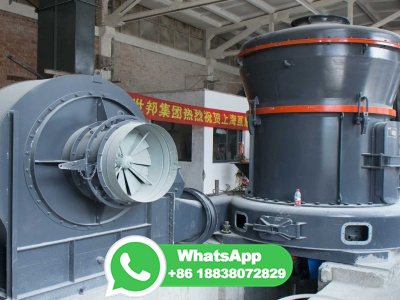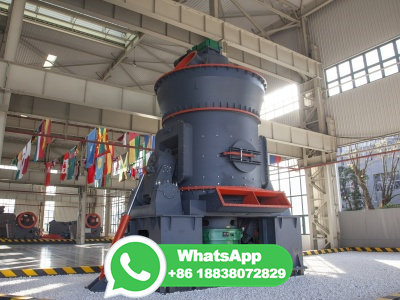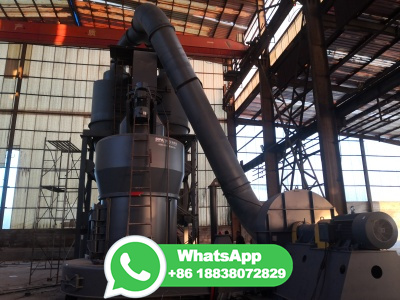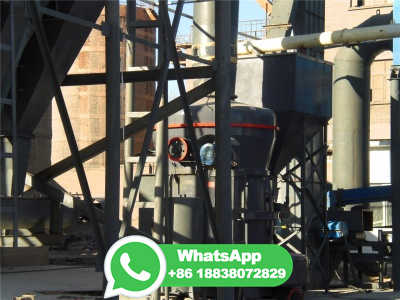
How does the wet grinding process work? The wet grinding process, also referenced as wet milling, can be looked at as a series of steps or "unit operations" that are used to manufacture raw materials into a finished product. These different stages involve several processes with various procedures that have been laid out and put into place.
WhatsApp: +86 18037808511
Grinding Test. In this paper, the wet ball milling process was used in the laboratory ball milling test. Before grinding, the ball mill was kept idle for 10 minutes and then washed together with the grinding media. Three types of ores were crushed and separated by a jaw crusher, and the ground particle size of 2 mm was selected.
WhatsApp: +86 18037808511
The principle of wet ball milling is based on the energy transfer between the grinding media and the material being ground. In the process of wet ball milling, the grinding media are typically made of steel or ceramics, and they are loaded into the mill in a specific proportion. As the cylinder rotates, the grinding media and the material being ...
WhatsApp: +86 18037808511
Ball milling, or media milling, uses collision and shear forces to grind down material, whether wet or dry. A ball mill can operate at either high or lowenergy outputs, and material characteristics can span a wide range. Adjustable variables include ball types and sizes, speeds, material mass in slurry, and more.
WhatsApp: +86 18037808511
Comminuting raw materials are extensively utilized in various industries such as food, cosmetics, electronics, pharmaceutical, cement, recycling, and mineral processing. ... can reduce energy consumption by 46% compared to a circuit in which there is a tertiary crushing with a wet ball mill. Additionally, the wet grinding process produces ...
WhatsApp: +86 18037808511
Dry grinding requires approximately 30 % more energy / wt. of ground material. Dry mills need more mill volume than comparable wet mills. However, the increased metal wear of the grinding media and the mill liners for wet grinding, equalizes the additional energy costs of dry grinding procedures ~ 30 40 % of wear costs in wet grinding.
WhatsApp: +86 18037808511
Mechanical Crushing and Grinding. Oleg D. Neikov, in Handbook of NonFerrous Metal Powders, 2009 Tumbling Ball Mills. Tumbling ball mills or ball mills are most widely used in both wet and dry systems, in batch and continuous operations, and on a small and large scale.. Grinding elements in ball mills travel at different velocities. Therefore, collision force, direction and kinetic energy ...
WhatsApp: +86 18037808511
Cutting edge technology. The wet grinding and dispersing process defines your end product characteristics. Our solutions include cuttingedge bead mills and threeroll mills, supported by unrivaled process and application expertise, to give you consistent, repeatable quality, every time. Bead mills. Threeroll mills.
WhatsApp: +86 18037808511
This grinding is done wet or dry, depending on the process in use, but for dry grinding the raw materials first may need to be dried in cylindrical, rotary dryers. Read More; In cement: Grinding. ... are used in mills that grind raw materials for the ceramic and paint industries; the use of flint pebbles instead of steel balls as a grinding ...
WhatsApp: +86 18037808511
What's more, the energy consumption of raw material grinding in the wet process is reduced by nearly 30%. Disadvantages: the heat consumption of the wet process is too high, usually between J/kg and the consumption of ball mill vulnerable parts is also large. ... The crushed materials from different silos and basins are drawn in ...
WhatsApp: +86 18037808511
The energy consumption of the total grinding plant can be reduced by 2030 % for cement clinker and 3040 % for other raw materials. The overall grinding circuit efficiency and stability are improved. The maintenance cost of the ball mill is reduced as the lifetime of grinding media and partition grates is extended.
WhatsApp: +86 18037808511
1. Keeping up with demanding production volumes. Wet milling can be a more timeconsuming process than most jet milling projects. It takes time to calculate solids percentages using material bulk density to properly set up equipment for an optimized process, and sometimes even to break down the particles.
WhatsApp: +86 18037808511
The dry raw mix is pneumatically blended and stored in specially constructed silos until it is fed to the pyroprocessing system. In the wet process, water is added to the raw mill during the grinding of the raw materials in ball or tube mills, thereby producing a pumpable slurry, or slip, of approximately 65 percent solids.
WhatsApp: +86 18037808511
As shown in the figure, the process can be divided into the following primary components: raw materials acquisition and handling, kiln feed preparation, pyroprocessing, and finished cement grinding. Each of these process components is described briefly below.
WhatsApp: +86 18037808511
In addition, the energy consumption of raw material grinding in wet processes is reduced by almost 30%. Disadvantages: The heat consumption of the wet process is very high, generally between J / kg and the consumption of the vulnerable areas of the ball mill is high. Compared with other processing methods, the clinker produced by the ...
WhatsApp: +86 18037808511
from raw materials by a combination of mechanical and ... (grinding or milling medium) and the powder. Advantages of this technique include costeffectiveness, reliability, ease of operation, reproducible results due to energy and speed control, applicability in wet and dry conditions on a wide range of materials ( cellulose, chemicals ...
WhatsApp: +86 18037808511
mills for drygrinding the abovementioned grinding stock. Loesche has developed and built the largest and most efficient grinding plants for its customers. Loesche plants are specifically planned for the required process steps and equipped with the associated techno logy. This technology comprises: • Processing plants and material storage
WhatsApp: +86 18037808511
Wet milling, also known as wet grinding, is a process through which particles that are suspended in a liquid slurry are dispersed in that liquid by shearing or crushing. Once the milling process is complete, these particles are ready for use or can be dried and separated for incorporation into additional products.
WhatsApp: +86 18037808511
Raw mill SEC (kWh/kgmat'l) Addition of Grinding Balls Watch raw mill SEC daily and add grinding balls in right timing →10% energy saving expected Ball diameter shrinks as time passes due to erosive effect. This leads to gradual increase of raw mill SEC. Filling level of grinding balls is also important in
WhatsApp: +86 18037808511
Grinding the raw biomass into smaller particles has a great impact on the storage and conveying properties and its suitability for a given application. There are two types of grinding: coarse grinding and fine grinding. The raw biomass that is harvested from forests or fields goes through a coarse grinding process.
WhatsApp: +86 18037808511
Cement Grinding: cement grinding is the final stage in Portland cement manufacturing. In this step, clinker will be ground in grinding mill to reach the qualified fineness of cement product. During the grinding, we usually add gypsum, fly ash and other raw materials into the cement to realize the different usage of cement.
WhatsApp: +86 18037808511
The ball mill is used to grind many kind of raw material. 16. Clinker: The material are then fed through a kiln at ˚F to produce grayish black pellets know as clinker . 17. Clay Water Lime Stone Wash mill Crusher Storage Basins Storage Basins WET PROCESS OF CEMENT Wet grinding mill to make slurry 18.
WhatsApp: +86 18037808511
The wet process of cement manufacturing refers to grinding raw material into slurry after mixing with water and then feeding them into the wet process kiln for drying and calcination and finally forming clinker. The slurry's water content is usually between 32%36%.
WhatsApp: +86 18037808511
Since the raw materials must be dried before grinding and heating, the wet process takes longer than the dry process. The raw materials do not need to be dried before being ground and heated, hence the dry process is quicker than the wet process. 4. Consumes more fuel compared to dry process: Consumes less fuel compared to wet process: 5.
WhatsApp: +86 18037808511
Wet milling is a topdown process, where the raw material is broken down via mechanical forces. In this method, a sufficiently concentrated dispersion of drug particles in an aqueous or nonaqueous liquid medium is treated.
WhatsApp: +86 18037808511